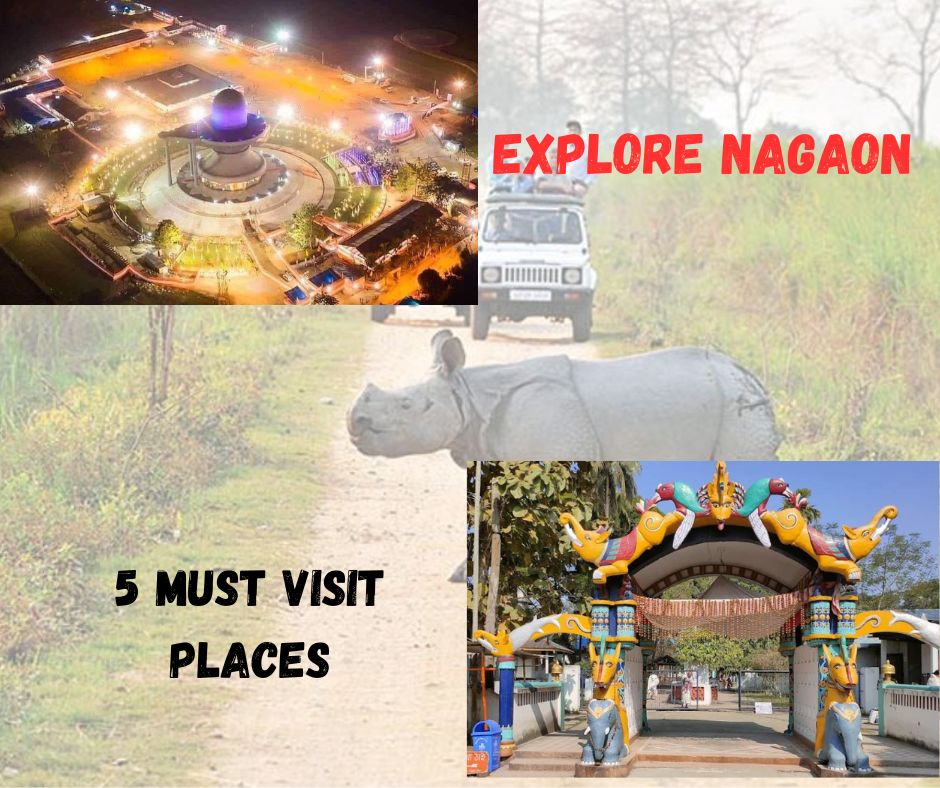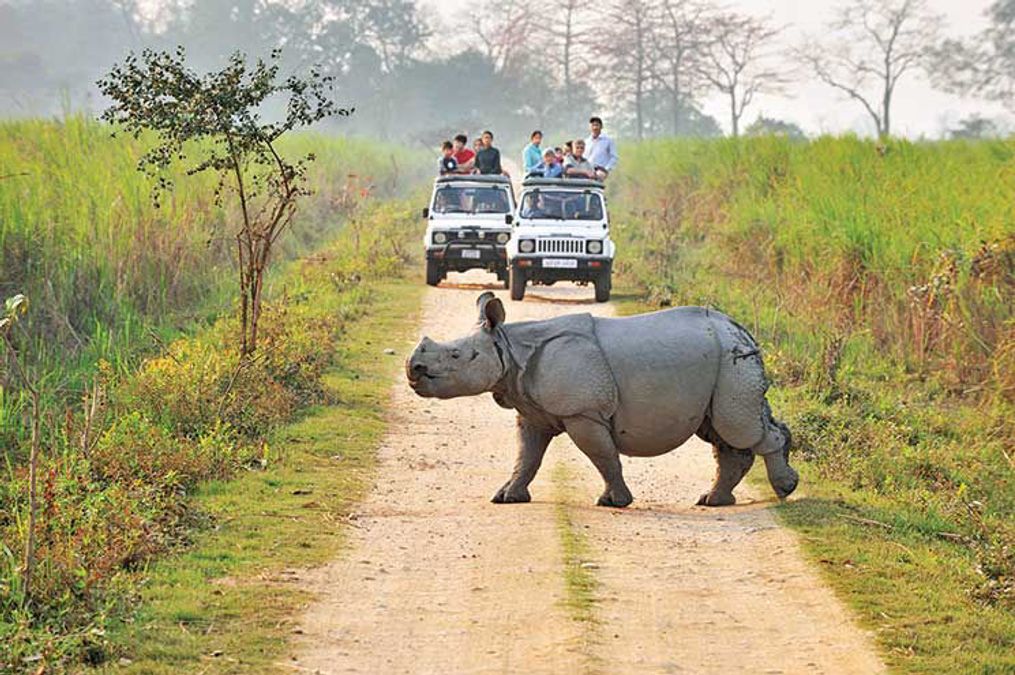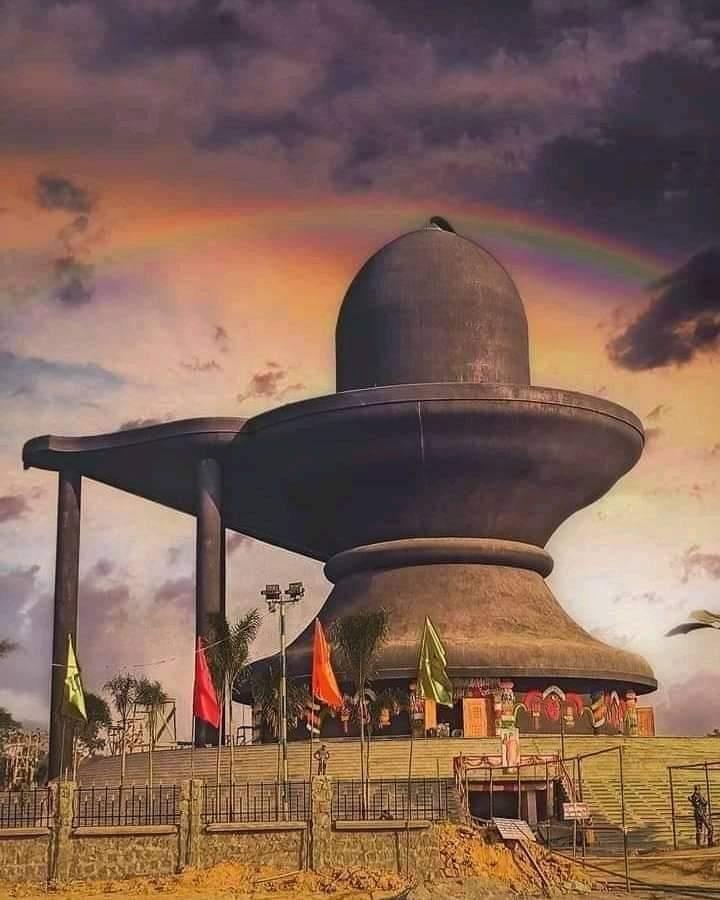
Explore the Enchanting 5 Best Places in Nagaon, Assam

 :
| Updated On: 09-Jul-2025 @ 4:47 pm
:
| Updated On: 09-Jul-2025 @ 4:47 pmSHARE
Kaziranga National Park

🦏 Why Visit Kaziranga National Park?
-
Home to the One-Horned Rhinoceros
Kaziranga hosts the world’s largest population of the endangered Indian one-horned rhinoceros, making it globally significant for wildlife conservation. -
UNESCO World Heritage Site
Recognized for its exceptional biodiversity and natural environment, Kaziranga is a UNESCO World Heritage Site since 1985. -
Rich Wildlife & Birdlife
Besides rhinos, the park is home to royal Bengal tigers, wild elephants, water buffaloes, swamp deer, and over 500 bird species, including migratory birds and rare species like pelicans and storks. -
Thrilling Safaris
-
Jeep Safaris across four zones (Central, Western, Eastern, and Burapahar)
-
Elephant Safaris for close-up rhino sightings during sunrise
-
Birdwatching tours especially in the Eastern (Agaratoli) Range
-
🗓️ When to Visit Kaziranga National Park?
-
Best Season:
November to April is ideal for wildlife sightings and comfortable weather. -
Park Open Season:
October 1 to May 31 (approximate dates; may vary slightly each year) -
Avoid Monsoon:
The park is closed from June to September due to heavy rains and flooding from the Brahmaputra River.
🚗 How to Visit Kaziranga National Park?
🛫 By Air:
-
Nearest Airport: Jorhat Airport (approx. 97 km) or Guwahati Airport (approx. 217 km)
-
Taxis and private cabs are available from both airports.
🚆 By Train:
-
Nearest Railway Station: Furkating Junction (75 km) or Guwahati Railway Station (5–6 hrs drive)
🚌 By Road:
-
Well-connected by NH-37, with frequent buses and taxis from Guwahati, Tezpur, Nagaon, and Jorhat.
🏨 Where to Stay?
-
Kaziranga offers a range of eco-lodges, resorts, forest bungalows, and budget guesthouses near the park gates like Kohora and Bagori.
📝 Travel Tips:
Samaguri Beel
-
Book safaris in advance, especially in peak season (Dec–Feb)
-
Wear neutral-colored clothes for safaris
-
Carry binoculars, a hat, sunscreen, insect repellent, and a camera
-
Respect wildlife and follow park guidelines strictly
🐦 Why Visit Samaguri Beel?
Birdwatcher's Paradise
Samaguri Beel is famously called "Pokhi Tirtha" (Bird Pilgrimage) because it becomes a haven for migratory birds during winter. Species like:
-
Lesser whistling ducks
-
Cotton pygmy geese
-
Terns
-
Storks
-
Herons
flock here from distant lands.
Tranquil Natural Beauty
The beel (oxbow lake) offers a peaceful environment surrounded by green fields, making it perfect for a quiet getaway, nature photography, and boating.
Eco-Tourism Potential
It’s still an offbeat and uncrowded location, ideal for travelers looking to explore Assam’s untouched wetlands and support rural eco-tourism.
📝 Tips for Visitors:
🛤️ From Other Cities:
🛣️ By Road:
🚗 How to Visit Samaguri Beel?
🗺️ Location:
🗓️ When to Visit Samaguri Beel?
Chapnalla (Champawati Kunda)

-
Carry binoculars and a camera for the best experience.
-
Wear comfortable shoes and light clothing in earthy tones.
-
Avoid littering – help preserve the pristine wetland ecosystem.
-
Boating (if available) should be taken with proper local guidance.
-
There's limited infrastructure, so carry snacks, water, and insect repellent.
-
Reach Nagaon by road or rail:
-
From Guwahati: ~2.5–3 hours by car or bus.
-
From Tezpur or Jorhat: Around 2–2.5 hours.
-
-
From Nagaon town, take a local taxi or auto-rickshaw (approx. 20–30 minutes).
-
If you're driving, follow the Raha–Nagaon road via NH-37 and take a diversion towards the Beel area (locals can help with directions).
-
Situated near Nagaon town, Assam – about 12–15 km from the town center.
-
It lies along the road towards Raha or Kampur depending on the approach.
-
Best Time:
October to March, especially November to February, when migratory birds arrive in large numbers. -
Early Morning or Evening:
Bird activity is highest during sunrise and sunset, and the lighting is also best for photography. -
Avoid Rainy Season:
The area can become marshy and less accessible during monsoon (June–August).
🌿 Why Visit Chapnalla (Champawati Kunda)?
Mesmerizing Waterfall – Champawati Kunda
Chapnalla is best known for the Champawati Waterfalls, a beautiful and refreshing cascade tucked amidst hills and forests. It’s a great spot for:
-
Nature lovers
-
Photographers
-
Families or friends looking for a picnic or trek
-
People wanting a peaceful escape from city life
Scenic Landscape & Fresh Air
Surrounded by tea gardens, streams, and hillocks, the area offers a cool, serene environment, perfect for relaxation and short treks.
Spiritual Vibe
There's a temple dedicated to Goddess Champawati nearby, adding a cultural and spiritual angle to your visit.
🛤️ By Train or Bus:
🛣️ By Road:
🚗 How to Visit Chapnalla?
🗺️ Location:
🗓️ When to Visit Chapnalla?
Maha Mrityunjay Mandir

-
Nearest major railway station: Haibargaon or Nagaon Railway Station
-
From there, take a cab or local transport to reach Chapnalla.
-
From Nagaon Town:
-
Take a private car, taxi, or rented vehicle. The drive takes about 45 minutes to 1 hour.
-
The last stretch may be slightly rough, so a sturdy vehicle is recommended.
-
-
From Guwahati:
-
~3 to 3.5 hours via NH-27 to Nagaon, then local route to Chapnalla.
-
-
Located in the Raha subdivision of Nagaon district, about 32 km east of Nagaon town.
-
Lies on the way to Kampur or Raha–Kampur road, depending on the approach.
-
Best Season:
October to February – This is post-monsoon when the waterfall is full, and the weather is pleasant for trekking and exploration. -
Avoid Rainy Season (June–August):
The area can become slippery and risky due to high water flow and muddy trails. -
Ideal Time of Day:
Morning to early afternoon is best to enjoy daylight, take pictures, and return safely before sunset.
🕉️ Why Visit Maha Mrityunjay Mandir?
World’s Tallest Shiva Lingam
This temple is home to the world’s tallest Shivalinga, standing at an impressive 126 feet, making it a major spiritual and architectural landmark in India.
Spiritual Significance
The temple is dedicated to Lord Shiva and especially the Maha Mrityunjay form, associated with healing, longevity, and protection from untimely death. Devotees chant the powerful Maha Mrityunjay Mantra here.
Stunning Architecture and Peaceful Ambience
The temple complex is beautifully built with sculptures and carvings that reflect traditional Hindu design. The serene surroundings and holy chants offer a peaceful and meditative atmosphere for visitors.
Ideal for All Visitors
Whether you’re a spiritual seeker, a lover of architecture, or simply exploring Assam, the temple is a must-visit landmark in Nagaon.
📝 Tips for Visitors:
🛤️ By Train:
🛣️ By Road:
🚗 How to Visit Maha Mrityunjay Mandir?
🗺️ Location:
🗓️ When to Visit Maha Mrityunjay Mandir?
-
Dress modestly as it is a place of worship.
-
Visit during early morning or late afternoon to avoid crowds and heat.
-
Don’t forget to explore the temple campus, which includes gardens, sculptures, and prayer halls.
-
Photography may be restricted inside sanctum areas—ask the temple staff.
-
If you’re visiting during Shivaratri or special puja days, arrive early due to large gatherings.
-
Nearest railway station: Haibargaon or Nagaon Railway Station
-
From there, take a local vehicle to reach the temple.
-
From Nagaon town: Auto-rickshaws, taxis, and buses are easily available.
-
From Guwahati:
-
About 120 km (3–3.5 hours) by road via NH-27
-
You can take a direct taxi or a bus to Nagaon and then a local vehicle to the temple.
-
-
Situated in Purani Godam, just 5–6 km from Nagaon town, Assam.
-
Best Season:
October to March – Pleasant weather and festive ambiance. -
Special Occasions:
-
Shivaratri (Feb–March) draws large numbers of devotees.
-
Mondays are especially sacred for Lord Shiva followers.
-
The temple also sees increased footfall during Sawan month (July–August).
-
-
Opening Hours:
Bordowa Than

-
Morning: 7:00 AM – 12:30 PM
-
Afternoon/Evening: 1:30 PM – 8:00 PM
🕉️ Why Visit Bordowa Than?
-
-
Birthplace of Srimanta Sankardev
Bordowa Than, also known as Batadrava, is the revered birthplace of Srimanta Sankardev, the 15th-16th century saint, scholar, and cultural icon who shaped Assam’s Neo-Vaishnavite tradition. -
Spiritual and Cultural Hub
It is an important Neo-Vaishnavite pilgrimage site featuring the Sattra (monastic institution), temples, and museums that preserve Assam’s religious heritage and traditions. -
Festivals and Bhaona Performances
The place hosts vibrant festivals, especially during Fagua (Holi) and other religious occasions, where traditional bhaona (devotional theatre) is performed, offering deep cultural insights. -
Peaceful Ambience
Surrounded by lush greenery and traditional Assamese villages, Bordowa Than offers a tranquil environment ideal for spiritual reflection and cultural exploration. -
🗓️ When to Visit Bordowa Than?
-
Best Time:
October to March for pleasant weather and easy travel. -
Festivals:
-
Fagua (Holi) festival in March is a spectacular time to experience cultural festivities.
-
Other religious events are celebrated throughout the year with special rituals and performances.
-
-
Anytime Visit:
The site is open year-round for pilgrims and tourists alike. -
🚗 How to Visit Bordowa Than?
🗺️ Location:
-
Located about 22 km north-east of Nagaon town, near the village of Bordowa (Batadrava).
-
🛣️ By Road:
-
From Nagaon town: Taxis, auto-rickshaws, and private vehicles can be hired. The drive takes about 40–50 minutes.
-
From Guwahati: Approximately 130 km, around 3.5–4 hours by road via NH-27.
-
🛤️ By Train:
-
Nearest railway stations: Nagaon or Haibargaon
-
From there, local transport or taxis can take you to Bordowa Than.
-
📝 Tips for Visitors:
-
Respect local customs and dress modestly, especially inside the Sattra and temples.
-
Attend a bhaona performance if possible, to witness traditional Assamese devotional theatre.
-
Carry water, snacks, and sun protection for comfortable travel.
-
Photography may be restricted in certain areas—ask permission.
-
Combine your visit with nearby cultural sites in Nagaon for a richer experience.